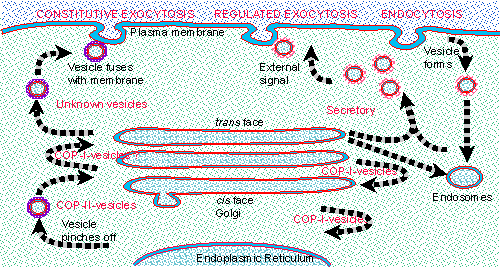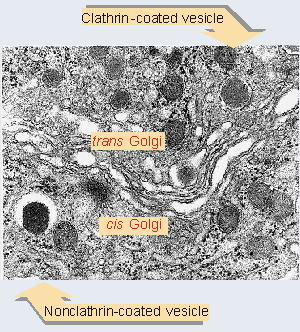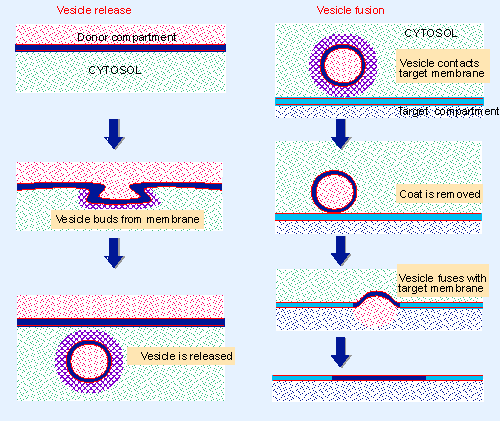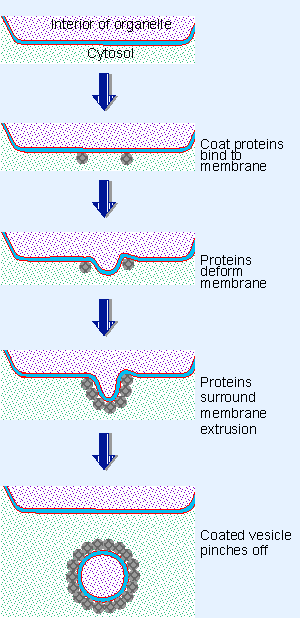4. Different types of coated vesicles exist in each pathway
25.3 Coated vesicles transport both exported and imported proteins |
| Key terms defined in this section |
| Coated vesicles are vesicles whose membrane has on its surface a layer of a protein such as clathrin, cop-I or COP-II. Endocytosis is process by which proteins at the surface of the cell are internalized, being transported into the cell within membranous vesicles. Exocytosis is the process of secreting proteins from a cell into the medium, by transport in membranous vesicles from the endoplasmic reticulum, through the Golgi, to storage vesicles, and finally (upon a regulatory signal) through the plasma membrane. Retrograde transport describes movement of proteins in the reverse direction in the reticuloendothelial system, typically from Golgi to endoplasmic reticulum. |
Secreted and transmembrane proteins start on the route to localization when they are translocated into the endoplasmic reticulum during synthesis. Transport from the ER, through the Golgi, to the plasma membrane occurs in vesicles. A protein is incorporated into a vesicle at one membrane surface, and is released from the vesicle at the next membrane surface. Progress through the system requires a series of such transport events. A protein changes its state of glycosylation as it passes from cis to trans compartments through the Golgi (for review see Farquhar, 1985; Pfeffer and Rothman, 1987).
 |
Figure 25.8 Proteins are transported in coated vesicles. Constitutive (bulk flow) transport from ER through the Golgi takes place by COP-coated vesicles. Clathrin-coated vesicles are used for both regulated exocytosis and endocytosis. |
Vesicles are used to transport proteins both out of the cell and into the cell. The secretion of proteins is called exocytosis; internalization of proteins is called endocytosis. The pathways for vesicle movement are pictured in Figure 25.8. The cycle for each type of vesicle is similar, whether they are involved in export or import of proteins: budding from the donor membrane is succeeded by fusion with the target membrane.
 |
Figure 25.9 Coated vesicles are released from the trans face of the Golgi. The diameter of a vesicle is ~70 nm. Photograph kindly provided by Lelio Orci. |
Vesicles involved in transporting proteins have a protein layer surrounding their membranes, and for this reason are called coated vesicles. Examples are shown in the electron micrograph of Figure 25.9. We discuss the types of protein coats below. The coat serves two purposes: it is involved with the processes of budding and fusion; and it enables the type of vesicle to be identified, so that it is directed to the appropriate target membrane. It is possible that the coat is also concerned with the selection of proteins to be transported.
One of the most remarkable features of protein trafficking is the conservation of the vesicular apparatus, including structural components of the vesicles, and proteins required for budding or fusion. Many of these functions have been identified through mutations of the sec genotype in S. cerevisiae, which are unable to export proteins through the ER-Golgi pathway (Novick et al., 1980). Many of the genes identified by sec mutants in yeast have direct counterparts in animal cells. In particular, the proteins involved in budding, fusion, and targeting in mammalian brain (where release of proteins from the cell provides the means of propagating nerve impulses) have homologs in the yeast secretory pathway (Sollner et al., 1993).
 |
Figure 25.2 Vesicles are released when they bud from a donor compartment and are surrounded by coat proteins (left). During fusion, the coated vesicle binds to a target compartment, is uncoated, and fuses with the target membrane, releasing its contents (right). |
 |
Figure 25.10 Vesicle formation results when coat proteins bind to a membrane, deform it, and ultimately surround a membrane vesicle that is pinched off. Animated figure |
The process of generating a vesicle requires a membrane bilayer to protrude a vesicle that eventually pinches off as a bud (see Figure 25.2). Such events require deformation of the membrane, as illustrated in Figure 25.10. Proteins concerned with this process are required specifically for budding, and become part of the coat.
In the reverse reaction, fusion is a property of membrane surfaces, and, in order to fuse with a target membrane, a vesicle must be "uncoated" by removal of the protein layer. A coated vesicle recognizes its destination by a reaction between a protein in the vesicle membrane and a receptor in the target membrane.
A vesicle therefore follows a cycle in which it gains its coat, is released from a donor membrane, moves to the next membrane, becomes uncoated, and fuses with the target membrane. When a vesicle is generated, it carries proteins that were resident in (or associated with) the stretch of membrane that was pinched off. The interior of the vesicle has the constitution of the lumen of the organelle from which it was generated. When the vesicle fuses with its target membrane, its components become part of that membrane or the lumen of the compartment. Proteins that are transported by vesicles (that is, which are not part of the structure of the vesicle itself) are called the cargo. Proteins must be sorted at each stage, when either they remain in the compartment or are incorporated into new vesicles and transported farther along the system.
The dynamic state of transport through the ER-Golgi system poses a dilemma. There is continuous movement of vesicles carrying proteins from the ER and through the Golgi. Movement in this direction is called forward or anterograde transport. In the course of ~20 minutes, a typical protein can pass through the system. A significant proportion of the membrane surface of the ER and Golgi is incorporated into vesicles that move to the plasma membrane. Such a flow of membrane should rapidly denude the Golgi apparatus and enormously enlarge the plasma membrane, yet both are stable in size. The net amount (and types) of lipid in each membrane must remain unperturbed in spite of vesicle movement.
The need to maintain the structure of the reticuloendothelial system suggests that there is a pathway for returning membrane segments from the Golgi to ER, so that there is no net flow of membrane. Movement in this direction is called retrograde transport. We do not yet understand the balance of forward and retrograde flow. One possibility is that some vesicles engaged in retrograde movement do not carry cargo, except for returning components to earlier parts of the system. Alternatively, reverse flow might occur by structures that have a high surface to volume ratio, such as tubules, which could thus return large amounts of material.
| Reviews | |
| Farquhar, M. G. (1985). Progress in unraveling pathways of Golgi traffic. Ann. Rev. Cell Biol. 1, 447-488. | |
| Pfeffer, S. R. and Rothman, J. E. (1987). Biosynthetic protein transport and sorting by the endoplasmic reticulum and Golgi. Ann. Rev. Biochem 56, 829-852. | |
| Research | |
| Novick, P., Field, C., and Schekman, R. (1980). Identification of 23 complementation groups required for posttranslational events in the yeast secretory pathway. Cell 21, 205-215. | |
| Sollner, T., Whiteheart, S. W., Brunner, M., Erdjument-Bromage, H., Geromanos, S., Tempst, P., and Rothman, J. E. (1993). SNAP receptors implicated in vesicle targeting and fusion. Nature 362, 318-324. | |